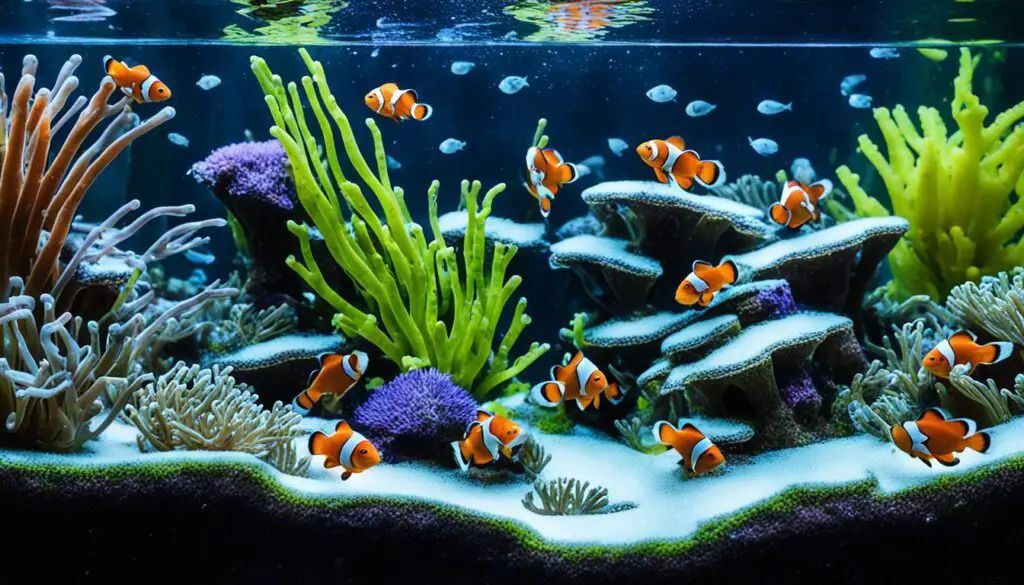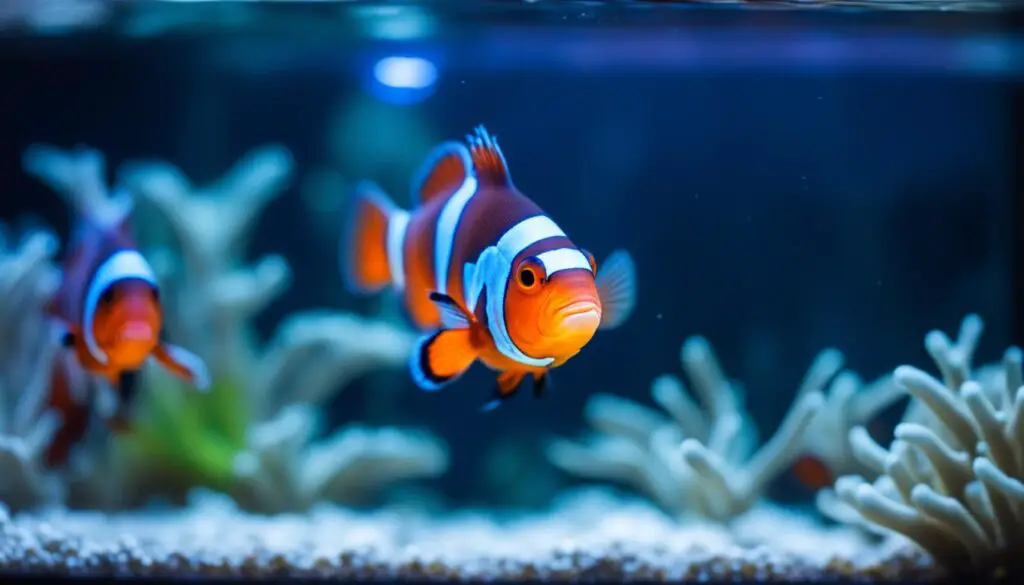Your Complete Guide to Clownfish Tanks: Setup and Maintenance
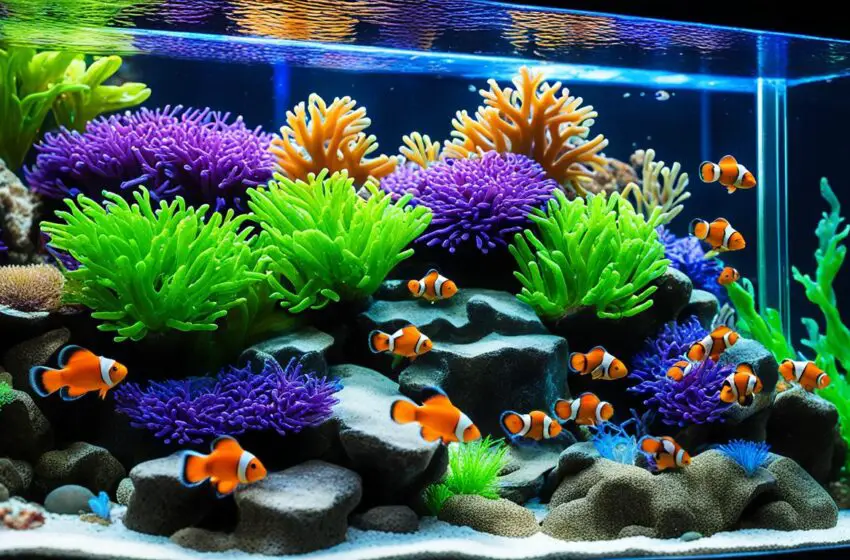
Welcome to your complete guide on setting up and caring for your clownfish tank. I’ll help you make a great home for your Ocellaris clownfish, also known as Nemo fish. They are colorful, fun fish that many people love to keep in their aquariums. They add life and beauty to any space.
Setting up a tank for clownfish takes some planning. Choosing the right size tank and keeping the water just right are crucial. I’ll walk you through each step, making it easy.
Clownfish can live over ten years, so they need a good place to call home. This guide will show you how to create the perfect environment. Your clownfish will be happy and healthy following these tips.
Key Takeaways:
- Choose the right tank size for your clownfish, with nano tanks of 8 to 10 gallons being suitable for Ocellaris clownfish.
- Consider providing a host, such as an anemone or coral, for your clownfish to seek refuge.
- Maintain optimal water quality through proper filtration, regular water changes, and monitoring of ammonia and nitrate levels.
- Ensure the temperature, pH, and salinity of the water are within appropriate ranges for your clownfish.
- Feed your clownfish a varied diet of high-quality flake or pellet food, supplemented with frozen or live foods.
Clownfish Tank Setup
To make your Ocellaris clownfish feel at home, you need to think about the tank, its size, and what goes in it. This will help your fish be healthy and happy. We’ll look at each part to help you set up the best tank for them.
Aquarium Size
For Ocellaris clownfish, a small tank between 8 to 10 gallons is perfect. It’s just the right size for them to show off their fun behaviors. You can really see them close up in a small tank.
Tank Setup
Your tank should look natural. Add live rock, sand, and plants. This makes the tank pretty and gives your clownfish places to hide and lay eggs. Make sure there’s enough room for your fish to swim comfortably.
Filtration
Having a good filter is key for your fish’s health. Use a filter that catches dirt and keeps the water clean. A protein skimmer or a hang-on-back filter can make your water even cleaner.
Anemone or Coral as a Host
Clownfish need a host like an anemone or a coral. This helps them feel at home and provides a beautiful natural setup. If you choose corals, make sure they’re safe for your clownfish.
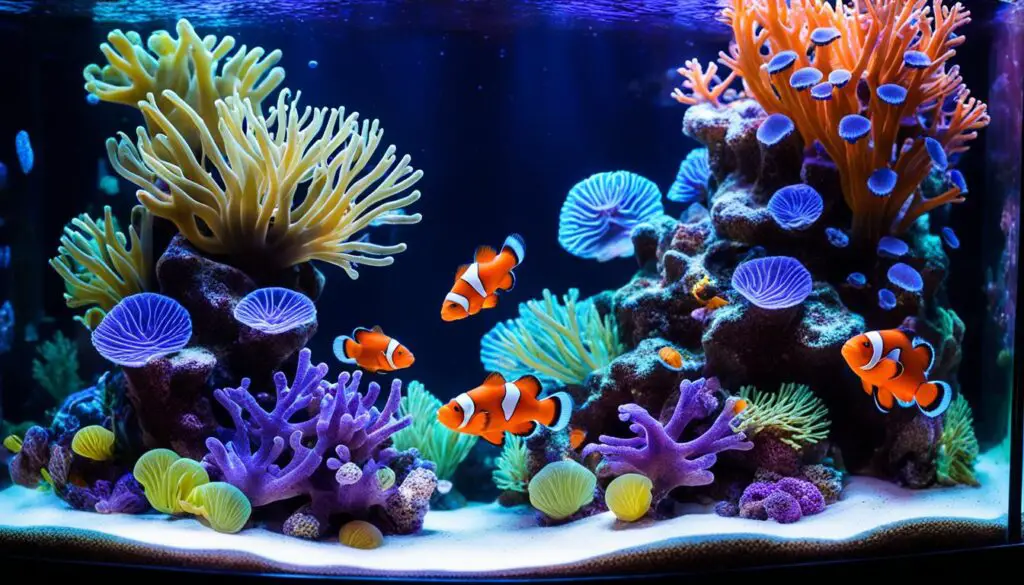
Water Quality
Good water means happy fish. Check the water’s health often by testing for ammonia and nitrate. Change some of the water regularly to keep it clean. Also, watch the temperature, pH, and salt levels.
| Key Factors | Recommendations |
|---|---|
| Aquarium Size | 8 to 10 gallons for Ocellaris clownfish |
| Tank Setup | Incorporate natural elements (live rock, sand, marine plants) |
| Filtration | Utilize a combination of mechanical, chemical, and biological filtration |
| Anemone or Coral as a Host | Provide a suitable host for clownfish refuge |
| Water Quality | Monitor ammonia and nitrate levels, perform regular water changes |
Feeding Your Clownfish
Clownfish are easy to feed and enjoy many types of food. A varied diet is key for their health. It helps keep their colors bright and prevents them from getting sick.
They like high-quality flake or pellet food. It should be made for meat-eaters or those that eat both plants and meat. This type of food has marine proteins and natural ingredients for a balanced meal.
Feeding them regularly is important for their wellbeing. For most tanks, once a day is good. But, in a small tank with just a few clownfish, feeding every other day could work too.
Give your clownfish a mix of foods to meet all their needs. This not only keeps them happy but also healthy. You can add to their diet with things like brine shrimp and copepods. These are close to what they eat in the wild.
Watch out for overfeeding to keep the water clean. Too much food can make the water bad for your fish. Feed them for only 2 to 3 minutes at any one time. This way, they eat it all quickly and there’s no extra food sitting around.
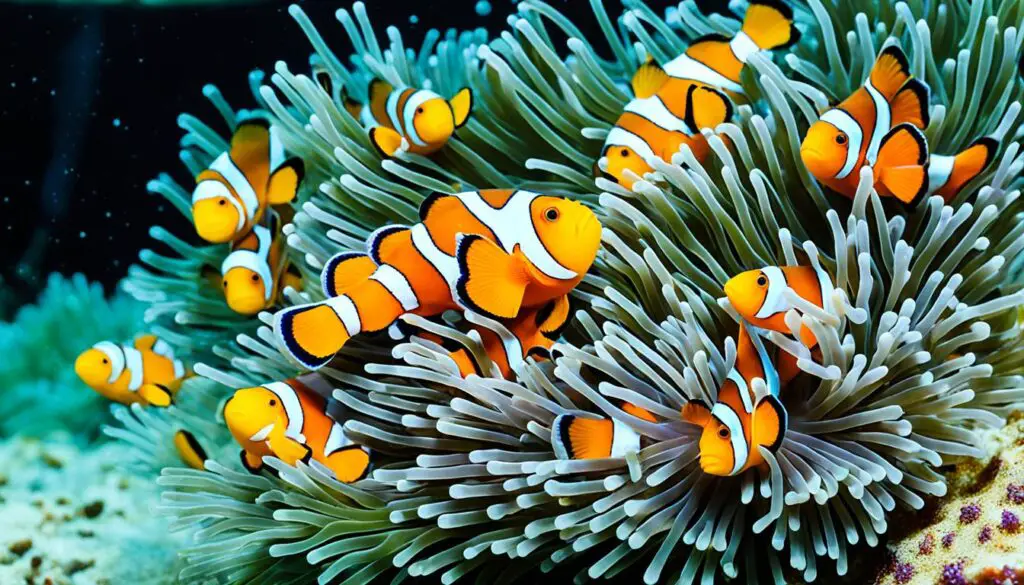
Use a cleanup crew to help keep the water clean. Snails and hermit crabs are great for this. And, change the water regularly and keep the filters running well. This keeps the water perfect for your clownfish.
Feeding Tips for Clownfish:
- Offer a variety of high-quality flake or pellet foods specifically designed for carnivores or omnivores.
- Include frozen or live foods such as brine shrimp and mysis shrimp to provide enrichment.
- Feed your clownfish at least once a day, adjusting the frequency based on tank size and population.
- Limit feeding sessions to 2-3 minutes to prevent food waste and poor water quality.
- Consider adding a cleanup crew to help maintain water quality.
| Food Type | Benefits |
|---|---|
| High-quality flake or pellet food | Provides essential nutrients, vitamins, and minerals |
| Frozen or live foods | Increases variety and enrichment |
| Snails and hermit crabs | Assist in cleaning uneaten food and algae |
Clownfish Compatibility and Final Thoughts
Creating a peaceful tank is important. Clownfish fit well with many other fish and sea creatures. They are calm and make the tank lively.
Be careful with several clownfish in one tank. They might not get along sometimes. To prevent fighting, introduce them correctly. Make sure there’s enough space for everyone to have their own area.
For those who really love fish tanks, breeding clownfish could be a fun challenge. But, this needs a lot of attention. You must create the right conditions for them to mate and take care of the babies.
In the end, having a tank with clownfish can be amazing. They not only look great but also teach us about ocean life. By selecting the right friends for your clownfish, welcoming them properly, and maybe even breeding them, your tank will flourish.
FAQ
What size tank is suitable for Ocellaris clownfish?
Nano tanks of 8 to 10 gallons are great for Ocellaris clownfish.
Do I need to provide a host, such as an anemone or coral, for Ocellaris clownfish?
Yes, it is vital to have a host for them to find refuge in.
What maintenance is required for a smaller tank?
Smaller tanks need more upkeep to keep the water clean. This includes proper filtration, regular water changes, and checking ammonia and nitrate levels.
What are the crucial water parameters for clownfish?
The right temperature, pH, and salinity are key for clownfish health.
What kind of food should I feed my clownfish?
Use high-quality flake or pellet food for carnivores or omnivores. It’s good to mix in some frozen or live foods for variety.
How often should I feed my clownfish?
Clownfish need feeding once a day. But they can also go every other day, depending on your tank’s size and who shares it with them.
How long should I feed my clownfish?
Feed them for 2 to 3 minutes. This helps avoid waste that can harm the water and grow algae.
Can clownfish be kept with other fish?
Yes, clownfish can live well with many other fish and marine creatures. This includes damselfish, tangs, blennies, angelfish, and more.
Can I keep multiple clownfish in the same tank?
Having more than one clownfish in a tank might lead to them fighting. But, if you introduce them correctly and give them enough space, it can work out.
Is breeding clownfish recommended?
Breeding clownfish means extra attention and care. Make sure you’re ready for the extra work before you start breeding.
Is maintaining a clownfish tank enjoyable?
Yes, owning and caring for a clownfish tank is fun and satisfying. It’s also a great way to learn about the amazing world of the reef.

